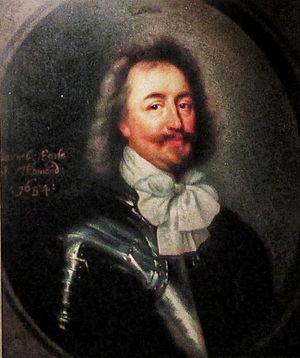Barnabas O'Brien, 6th Earl of Thomond facts for kids
Barnabas O'Brien, 6th Earl of Thomond (born 1590, died November 1657) was an important Irish nobleman. He became the Earl of Thomond in 1639. Barnabas was involved in the politics of his time. He tried to stay neutral during a big rebellion in Ireland. Later, he supported King Charles I of England.
Contents
Life of Barnabas O'Brien
Barnabas O'Brien started his political career in 1613. He became a member of the Irish House of Commons. This was like being a representative for the town of Coleraine.
In 1634, he was chosen to represent two areas. These were County Clare and Carlow. He worked alongside his uncle, Daniel O'Brien.
Becoming the Earl
In 1639, Barnabas became the sixth earl of Thomond. He took over after his brother, Henry O'Brien, 5th Earl of Thomond, passed away. Barnabas wanted to be the governor of Clare.
However, a powerful leader named Thomas Wentworth, Earl of Strafford refused his request. Strafford felt Barnabas did not deserve the position. Despite this, Barnabas was made Lord-lieutenant of Clare. He also became Custos Rotulorum in 1640–41. These were important roles in the county.
Staying Neutral in a Rebellion
A major event called the Irish Rebellion of 1641 began. Barnabas tried to remain neutral during this conflict. Many of his relatives supported the rebellion. But Barnabas did not join them or sign their agreements.
He lived quietly on his lands in Clare. He often communicated with James Butler, 1st Duke of Ormonde. Ormonde was a key figure in Irish politics.
Trouble at Bunratty Castle
In 1644, the leaders of the Confederation took action against Barnabas. They stopped his agents from collecting his rents. They even planned to take over his main stronghold, Bunratty Castle. His uncle, Sir Daniel O'Brien, was supposed to carry out this plan.
Barnabas realized he had no soldiers to defend Bunratty Castle. So, he started talking with the Parliamentarians. These were people who supported the English Parliament. His relative, Murrough O'Brien, 1st Earl of Inchiquin, encouraged him.
Barnabas allowed Parliament's soldiers to enter the castle. After this, he moved to live in England.
Supporting the King
Soon after, Barnabas joined King Charles I. The King was in Oxford at the time. On May 3, 1645, the King planned to make Barnabas the Marquis of Billing. This was a high title.
However, this title was never officially given to him.
Later Life and Legacy
A few years later, Barnabas asked the English Parliament for money. He wanted back £2,000 that had been taken at Bunratty. He explained that Irish rebels controlled his lands. He also said he had spent £16,000 helping the Parliament's cause.
Parliament agreed to his request. Barnabas seemed to have no issues with the new government in England. He died in November 1657. His will, a legal document about his wishes, was approved in 1657.
Historians noted that Barnabas was seen as very loyal and honorable. It was believed his lands were taken during the rebellion because of his relatives' actions. Some also thought he gave up Bunratty Castle because Ormonde told him to.
Family of Barnabas O'Brien
Barnabas was the second son of Donogh O'Brien, 4th Earl of Thomond. His mother was Elizabeth, who was the fourth daughter of Gerald FitzGerald, 11th Earl of Kildare.
His older brother was Henry O'Brien, 5th Earl of Thomond. Henry became the Earl when their father died in 1624. Henry was very loyal to the government in Ireland. He was praised by Thomas Wentworth, Earl of Strafford for his loyalty. Henry died in 1639 without any sons. This is how Barnabas became the Earl.
Barnabas married Anne, the youngest daughter of Sir George Fermor. Anne had been married before.
Barnabas and Anne had one son named Henry O'Brien, 7th Earl of Thomond. Henry was born in 1621 and later became the 7th Earl. They also had one daughter, Penelope. Penelope married Henry Mordaunt, 2nd Earl of Peterborough.


